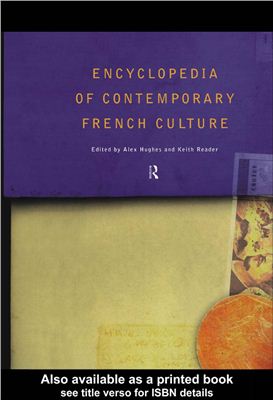This encyclopedia, current through 1997, presents over 700
alphabetical entries on key aspects of French culture since 1945
.
Some examples of entries are AIDS, cinema, detective fiction, gastronomy, legal system, Pompidou Centre and the Forum des Halles, poststructuralism, racism/anti-Semitism, and student revolt of 1986. People covered in biograpical entries have contributed to the culture in a variety of ways and include, among others, Isabelle Adjani, Roland Barthes, Christian Dior, Le Corbusier, and Jean-Marie Le Pen. Lengthy articles (up to four pages) are generally reserved for such broad topics as architecture, feminist thought, and psychoanalysis. Most articles have useful cross-references either embedded or appended. Longer articles also include annotated suggestions for further reading. Many of the cited works are in French, making the book most useful as a starting point for in-depth research for those with at least reading fluency in that language. There are, however, enough English-language sources to help the monolingual researcher. In addition to the index, there is a "classified contents list" that groups topics by subject.
Some examples of entries are AIDS, cinema, detective fiction, gastronomy, legal system, Pompidou Centre and the Forum des Halles, poststructuralism, racism/anti-Semitism, and student revolt of 1986. People covered in biograpical entries have contributed to the culture in a variety of ways and include, among others, Isabelle Adjani, Roland Barthes, Christian Dior, Le Corbusier, and Jean-Marie Le Pen. Lengthy articles (up to four pages) are generally reserved for such broad topics as architecture, feminist thought, and psychoanalysis. Most articles have useful cross-references either embedded or appended. Longer articles also include annotated suggestions for further reading. Many of the cited works are in French, making the book most useful as a starting point for in-depth research for those with at least reading fluency in that language. There are, however, enough English-language sources to help the monolingual researcher. In addition to the index, there is a "classified contents list" that groups topics by subject.

